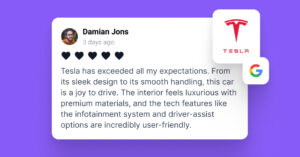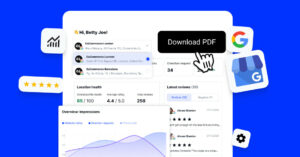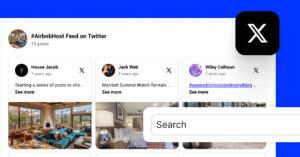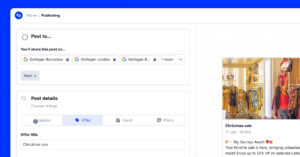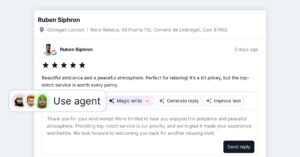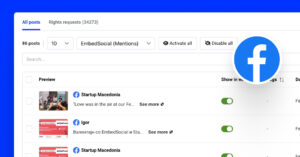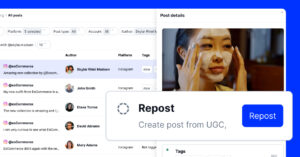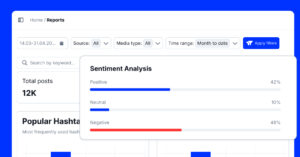In recent years, user-generated content (UGC) has emerged as a growth channel for small businesses. After all, it helps entrepreneurs build a strong connection with their audience, create a community around their brand, and deepen their customer engagement.
Just like Coca-Cola’s groundbreaking “Share a Coke” UGC campaign, which bumped the company’s sales by 2% in the U.S., you can use UGC to create an emotionally appealing campaign that will get your customers talking and sharing your brand’s awesomeness.
What is user-generated content (UGC)?
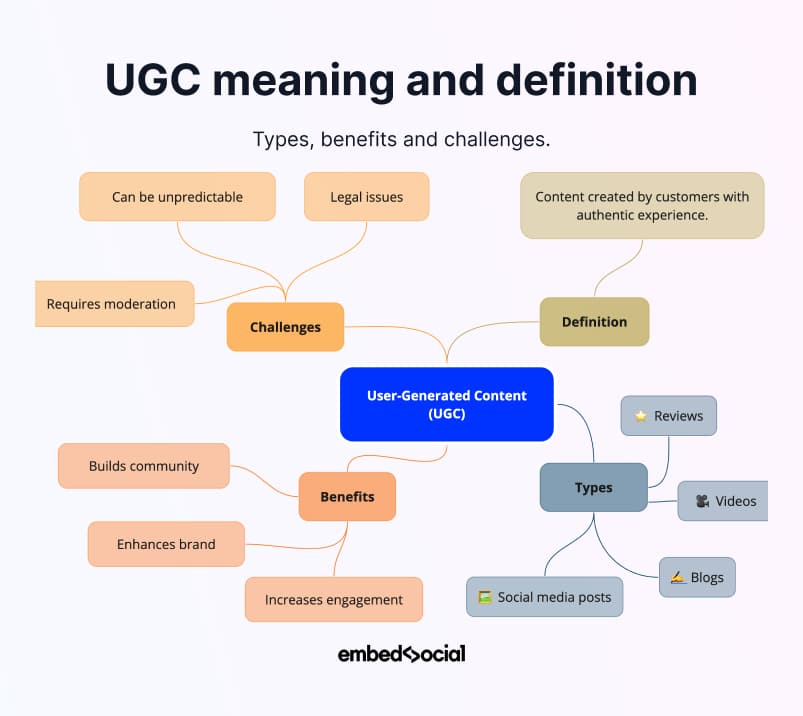
So what does UGC stand for, and what is it used for? Here’s the run-down:
User-generated content (aka UGC or consumer-generated content) is a marketing term that refers to a form of original content created and published by brand customers and advocates across their social media channels and online platforms.
Essentially, UGC is the content your users create in support (or not) of your business. As such, it’s the perfect social proof to boost your marketing efforts since it comes with various benefits and in different forms, including UGC videos, photos, testimonials, etc.
Here’s an example of a testimonial about EmbedSocial, which is a common form of UGC:
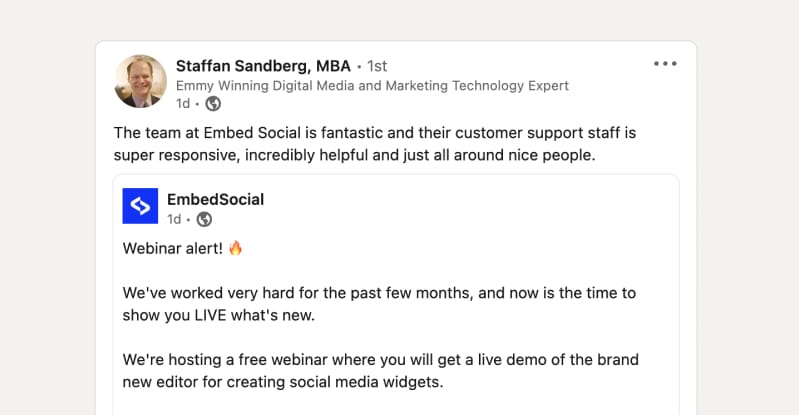
Differences between user-generated and influencer content
While user-generated content (UGC) and influencer-generated content (IGC) are created by people who do not work for the company in question, the brand has some control over the second type as it collaborates with influencers to generate the content.
Here’s how both types of content compare to each other:
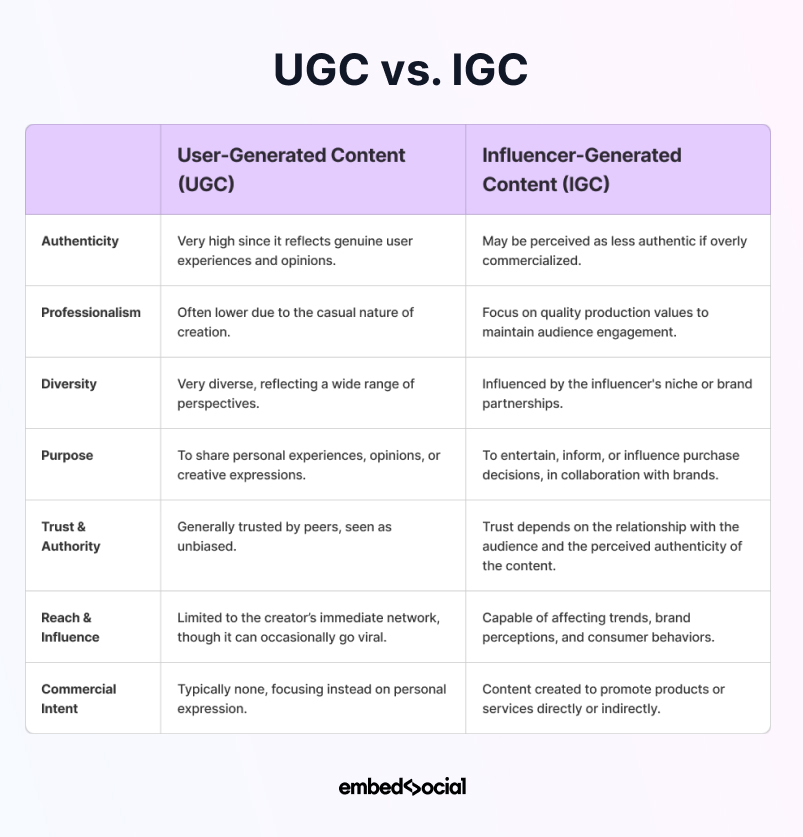
As you can see, modern businesses should use both types of content to boost their marketing efforts since the first one fosters genuine authenticity and encourages user engagement, while the second one leverages the influencer’s fame for targeted reach.
Types of consumer-generated content
UGC comes in different flavors, each with its own pros and cons when it comes to planning the perfect marketing strategy and reaching your audience. That said, you should combine more than one of the following types of UGC to cater to different customer segments:
- Social media photos & videos – this category includes all the engaging, visually rich posts that consumers share across social media, including images in feeds, stories, Instagram reels, and videos that highlight the user’s real experience with a brand;
- Customer reviews, testimonials, and ratings – customer reviews, testimonials, and ratings are organic UGC that can be found on Google, social platforms, on your product pages, and via review aggregators like Tripadvisor, Yelp, G2, and Trustpilot;
- Recommendations in tweets, groups, or forums – people give recommendations on social media for the products and services they purchase. Therefore, Facebook groups, various forums, and even X are popular destinations for prospective buyers;
- Customer interviews & case studies – long-form customer interviews and success stories are great at revealing the advantages and disadvantages of products and work wonders to prompt purchases, especially in B2B industries for significant purchases;
- Blog posts with expert reviews – this very particular format is most effective in industries such as travel, tech or gadgets, fashion, and food, but in general, it can be applied to any service or product because it takes an expert to evaluate your product;
- DIY & how-to content – social media users now create DIY and how-to content for products they’ve been using for a long time and often in unique ways; this content is authentic, relatable, user-centric, and offers real-life insights into product features.
To take full advantage of this type of UGC, establish an online reputation management process that manages and showcases your best customer reviews.
Imagine the benefits you get once you embed such content on your website.
Other UGC types based on their source
We should also cover employee-generated content (EGC) and paid UGC, which include certain incentives, unlike the unprompted organic UGC mentioned above.
Employee-generated content (EGC)
Similar to organic UGC, employee-generated content (EGC) is authentic content covering your brand, products, and services. The difference is that it’s created by your employees instead of random customers on social media, forums, and other online platforms. This content offers an authentic view of the company’s culture and operations, a unique perspective that external UGC can’t capture. Plus it humanizes the brand and showcases its values and the team behind its success.
As an example, check out this friendly Ferrari post showcasing their two F1 drivers having fun during the Grand Prix weekend in Japan:
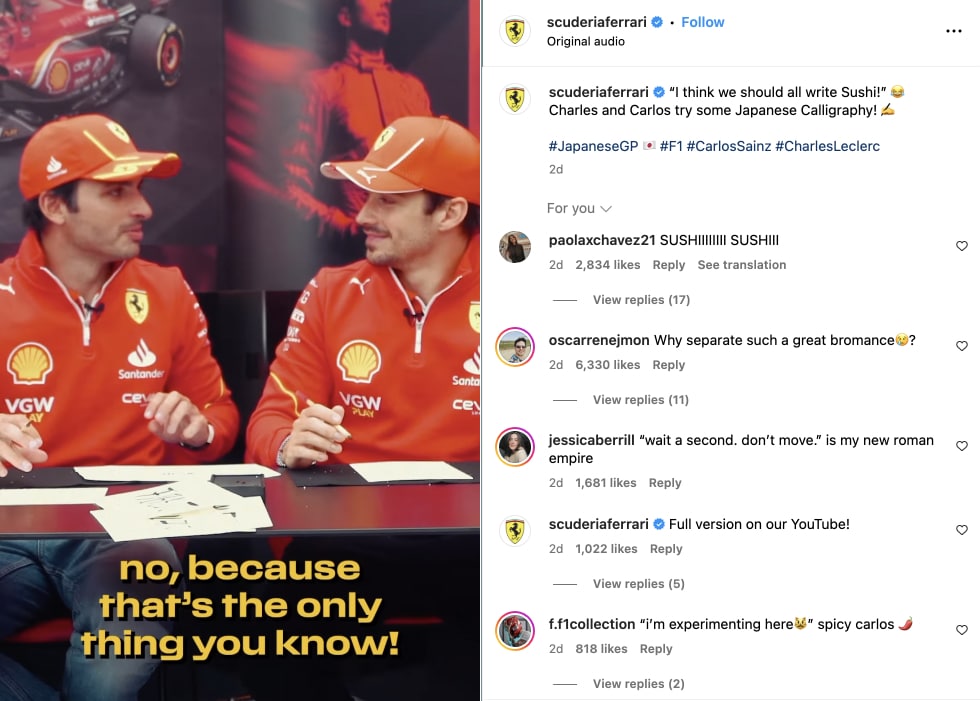
Paid user-generated content
Instead of looking for unprompted UGC on social media, you can also collaborate with UGC creators who will make and distribute fresh and engaging content for you.
The process starts when brands search for influencers or content creators who specialize in their niche market, such as fashion, food, travel, or similar. Once they discover them, they incentivize them to use their products or services and share their experiences.
For example, check out this customer sharing a series of photos via Instagram Stories of a brand gift they’ve received:
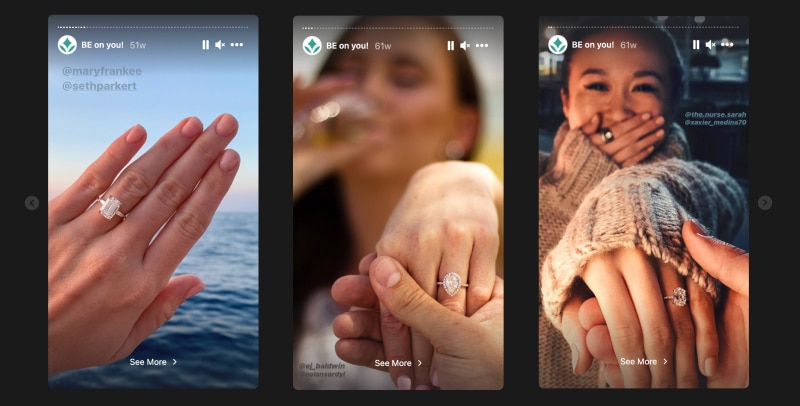
Sources of user-generated content
Anyone can create UGC nowadays as modern consumers have access to the internet and different social media platforms where they post text updates, photos, videos, reels, and everything in between. Therefore, you’ll be able to collect UGC from users such as:
- Everyday social media users – regular users on social media platforms like Instagram, Twitter, Facebook, TikTok, and YouTube are the largest group that creates UGC as they love sharing their life experiences and opinions about various brands and products;
- Brand customers and advocates – your actual customers and brand advocates will also often share reviews, testimonials, photos, and videos of the products and services they’ve used on platforms like Google, Amazon, Yep, Tripadvisor, etc.;
- Mainstream and micro-influencers – partnering with social media users with large followings (or a smaller and engaged audience) can help you create genuine content that will reach a very targeted niche and achieve your marketing goals;
- Professional content creators – travel enthusiasts, photographers, gamers, artists, activists, and other groups of bloggers and creatives post high-quality content on social media, and they would make great partners for your UGC marketing campaign.
All of these creators like sharing their experiences, knowledge, opinions, and creativity without requiring any particular incentive from you. This is the authenticity that helps you use UGC to influence trends and opinions, and tip over your website visitors into loyal followers.
Examples of user-generated content campaigns
Need fresh ideas for your next user-generated marketing strategy?
Take a look at these great examples of users and companies leveraging customer-generated content to increase brand awareness and grow their online reach.
1. Steven Wommack creates engaging Instagram tutorials
Valuable user-generated content (UGC) doesn’t come more impactful than how-to tutorials created by Instagram influencers who explain how to best use a certain feature. For instance, @stevenwommack shows his hordes of loyal fans how to use Reels here:
2. CLUSE shows off UGC photos on their website
The watch company CLUSE wants to inspire potential buyers to create the ultimate look using their products. The way they do that is by posting all the UGC they collect of everyday consumers wearing CLUSE items, and these followers only had to tag #CLUSE on Instagram:
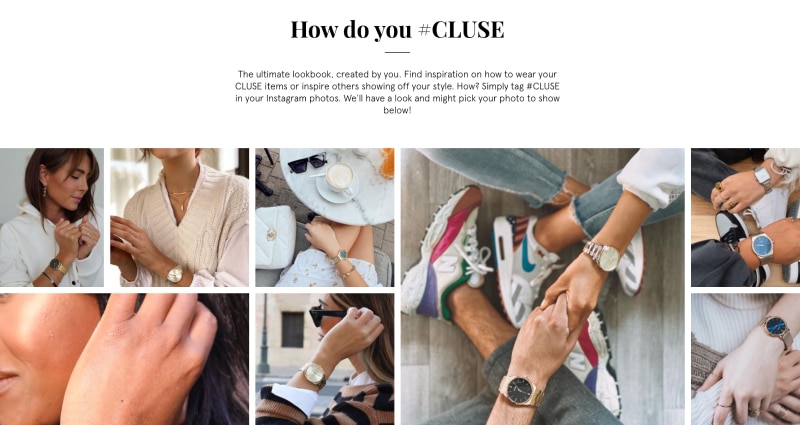
3. Cybertruck customers fuel a viral UGC movement
The launch of Tesla’s Cybertruck ignited a massive organic UGC campaign that boosted the product’s buzz, predominantly driven by new customers sharing their excitement through social media posts, including road tests and showcases of the vehicle’s features.
The result: one of the best social media marketing campaigns out there that became a powerful testament to the product’s appeal and customer satisfaction. Here’s how entrepreneur Alexis Ohanian shared his experience with the Cybertruck on social media:
4. Outdoor Voices creates successful hashtag campaigns
The athletic wear company Outdoor Voices is on a mission to get the world moving. To reach their goal, they invite their customers to get moving and show the world how they do it with the hashtag #DoingThings while wearing the brand’s clothing:

5. GoPro has nailed the UGC game from the start
Do you know who has the best consumer content out there?
GoPro! Yes, camera company, and they do that by letting their customers show off the awesomeness of their products, and they don’t even have to spend a cent for that!
As an example, check out GoPro’s Million Dollar Challenge, which has generated a ton of free marketing content thanks to customers sharing all kinds of thrilling videos:
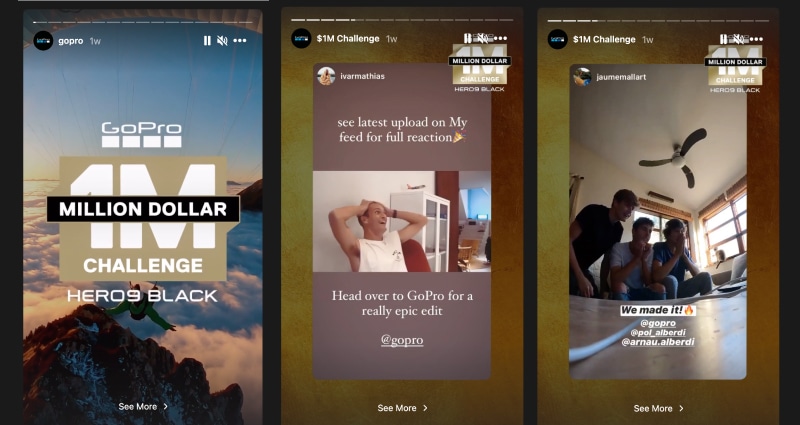
6. ChatGPT owes much of its growth to creators’ content
Social media creators and thought leaders on professional platforms like LinkedIn and YouTube proved to be a driving force in the growth of today’s most popular AI language model. All they keep on doing is showing the public the best ways to use ChatGPT.
Here’s one such example offered by YouTuber Daragh Walsh:
7. Spotify Wrapped is everyone’s favorite musical journey
As many of you might know, Spotify Wrapped is an innovative and widely celebrated user-generated content campaign that has become a yearly tradition for its users.
What it entails is a personalized wrap-up of the yearly listening adventures of the platform’s users, which helps the brand develop a relationship with its consumers. After all, music is part of everyone’s journey, and Spotify shows us just how important that is.
Users love sharing their #SpotifyWrapped across social media:
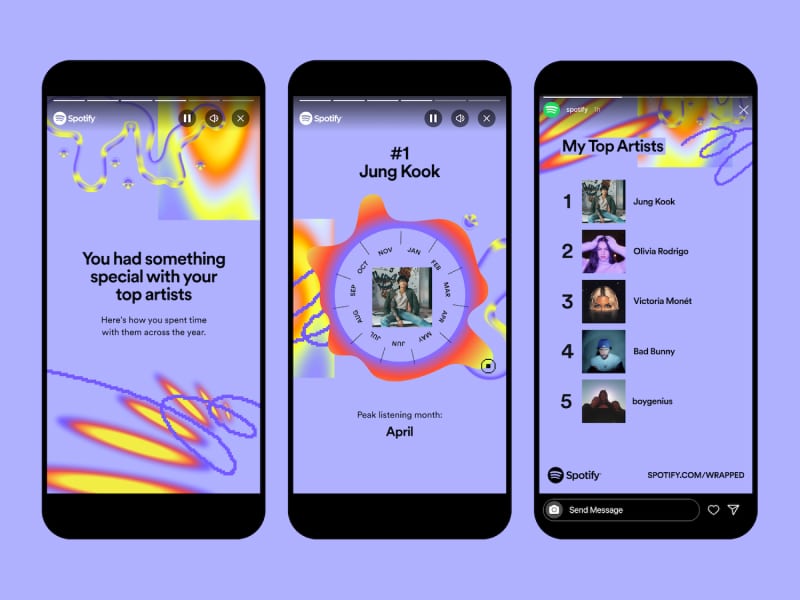
Read more:
Where do brands utilize user-generated content?
Once you collect all the UGC you need, what’s next?
You need to start using the content in your marketing efforts by repurposing and embedding your UGC where it will have the most impact, such as here:
1. Use UGC in your social media campaigns
Example: Dove’s #RealBeauty campaign
Dove’s #RealBeauty campaign is a pioneering use of user-generated content that challenges beauty stereotypes and promotes body positivity as it encourages women to share their own stories, photos, and videos on social media to redefine what beauty means:

2. Place reviews on your wall of love
Example: Leisuretec’s ‘Wall of Love’ page
This new trend sees companies and brands creating entire web pages full of reviews and testimonials so their visitors are welcomed by all the great things customers have to say about them. One great example of that is Leisuretec’s ‘Wall of Love’ page:
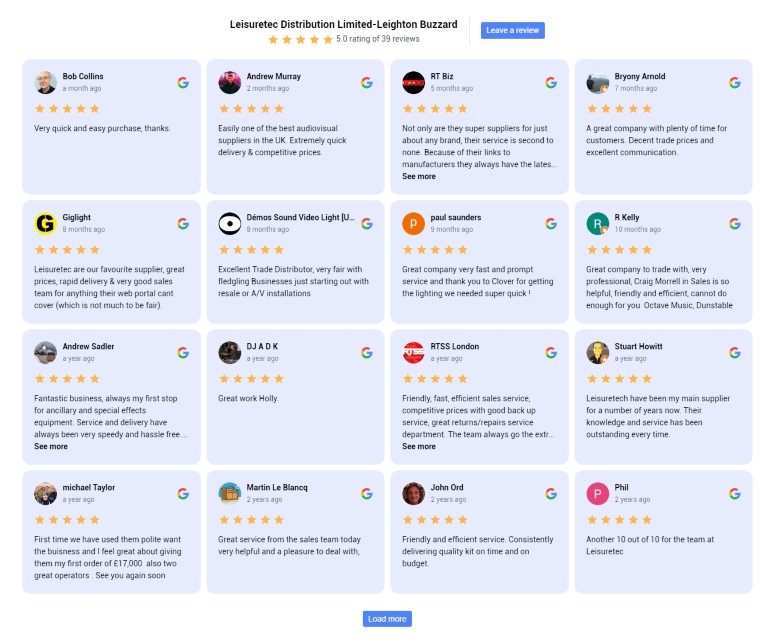
3. Enhance your website content with it
Example: Airbnb showcases its hosts’ stories
Airbnb features stories from its hosts on its website, thus providing social proof of the quality and diversity of its accommodations and building a deeper connection with both current and potential hosts and guests, which sets it apart from traditional hotels:
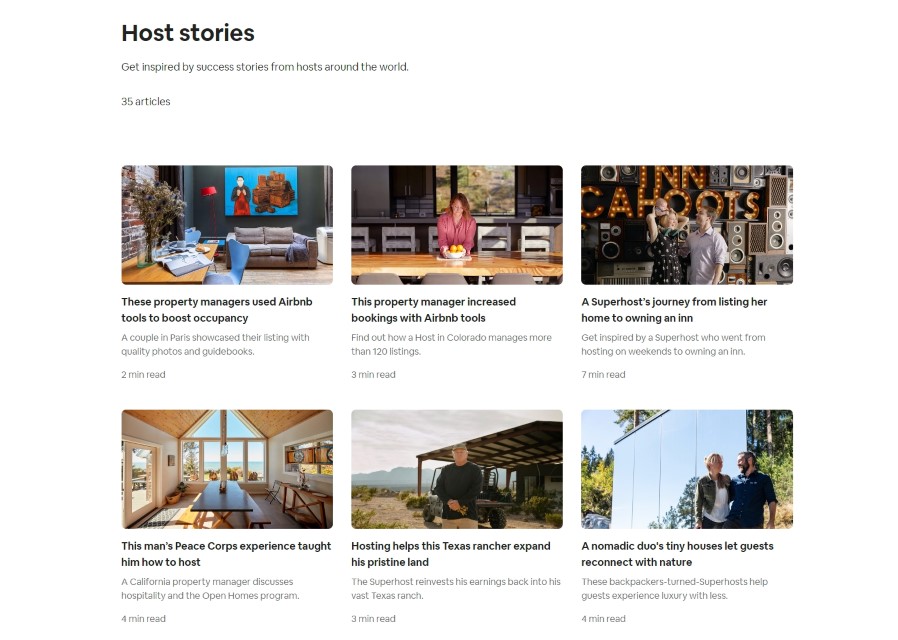
4. Make a shoppable feed with it
Example: ASOS’s #AsSeenOnMe shoppable feed
Some brands embed their customers’ photos from social media on their websites and tag the products their customers are wearing or using to build the perfect ‘Shop my feed’ section. That way, they showcase the product in action and streamline the shopping experience. Here’s how ASOS uses the #AsSeenOnMe hashtag to create the perfect shoppable Instagram feed:

5. Boost your customer support and FAQ sections
Example: Sephora’s Beauty Insider community
Sephora’s Beauty Insider Community is a platform where customers can ask questions and share beauty tips, recommendations, and product reviews, and this peer-to-peer advice exchange enhances the shopping experience for the brand’s customers:
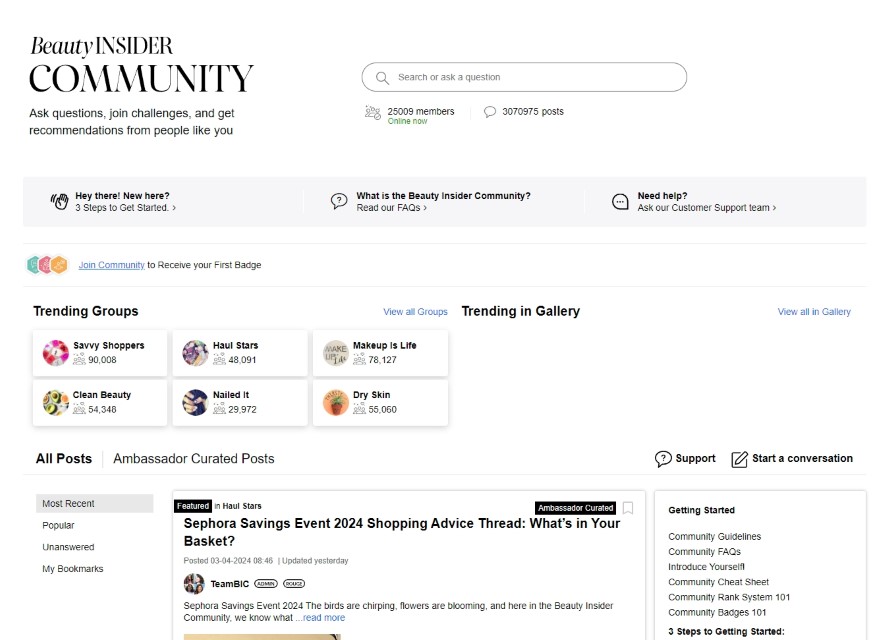
6. Include it in your contests & giveaways
Example: National Geographic’s #WanderlustContest
To enhance its website with engaging user-generated content, National Geographic launched the #WanderlustContest, inviting travelers from around the globe to submit their own photos capturing the essence of exploration and adventure and add the #wanderlustcontest tag to them. The prize? various travel and photography expeditions with the Nat Geo team:
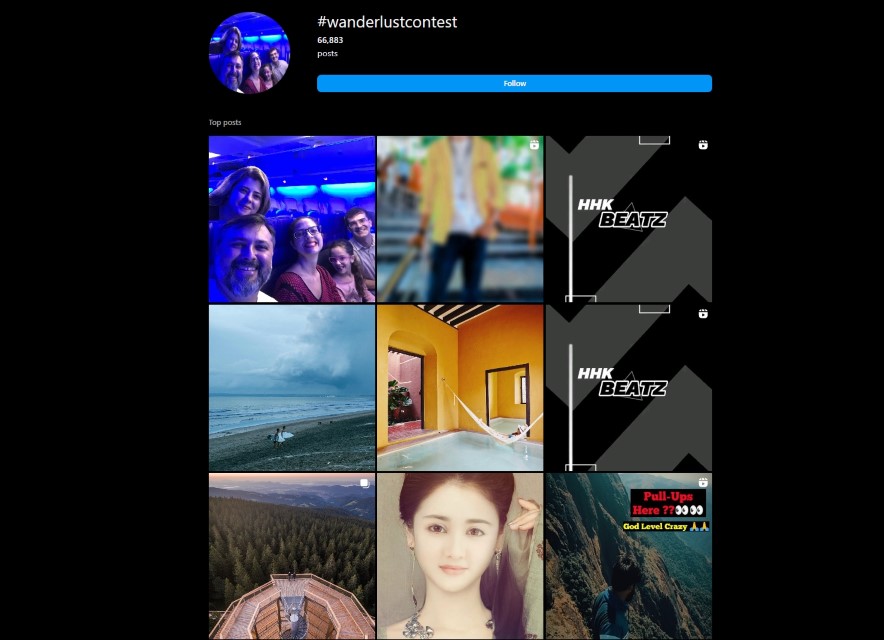
7. Add it to your email campaigns
Example: Glossier’s email campaigns
The beauty brand Glossier often incorporates UGC into its email marketing campaigns to showcase customer favorites and feature real user testimonials as seen below. These emails serve as personalized product recommendations and foster a sense of community:
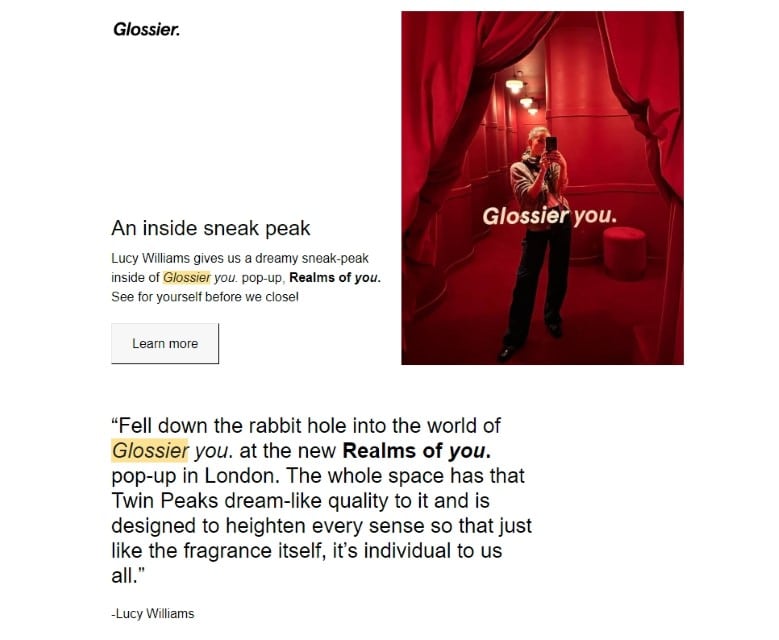
8. Design your advertisements with it
Example: Apple’s “Shot on iPhone” campaign
Apple often features photos and videos taken by iPhone users in its advertising campaigns in the real world to highlight the phone camera’s capabilities and put their users’ creativity front and center, serving as powerful social proof of the product’s quality. Check out how these images were printed and placed on billboards in various locations:
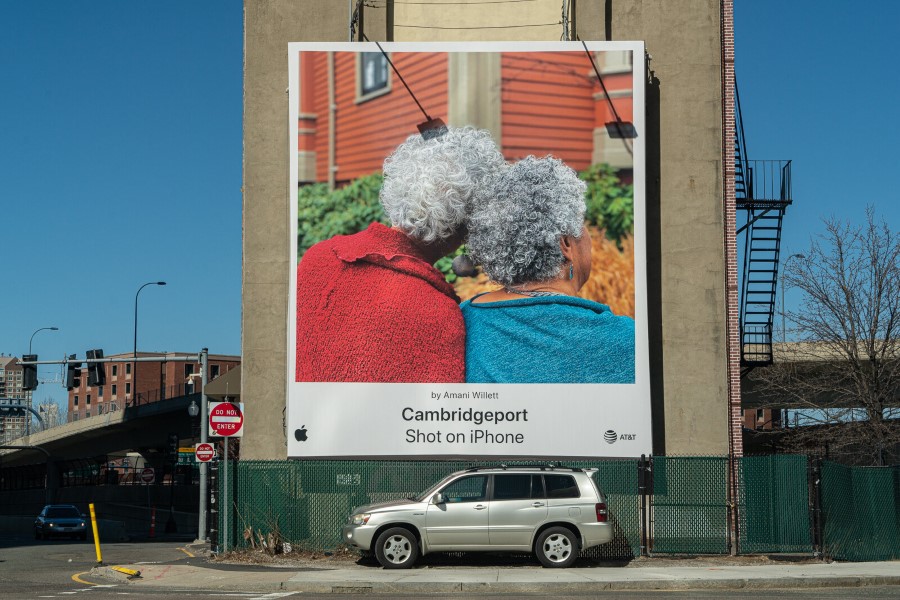
Benefits of user-generated content in 2024
UGC is the golden ticket in the digital marketing funnel due to its super-efficient returns, as it costs little to nothing to get and use. Plus, it comes with several benefits:
- Humanizes your brand – there’s no better way to build trust in your brand than to humanize it and bring it closer to your customers—UGC does that extremely well since consumers trust its raw and unsolicited authenticity;
- Adds authenticity & credibility – this uniquely authentic content drives higher engagement, which is evident from the surge in comments, likes, and brand mentions by down-to-earth customers praising you on social media;
- Influences your conversion rates – UGC significantly influences the consumer decision-making process, which ultimately tips over potential visitors to loyal customers and brand advocates since they are more inclined to buy from you;
- Rebuilds your brand trust and offsets negative perceptions – UGC helps in (re)building or strengthening the loyalty and trust consumers have in your brand and services, especially if you have faced challenges or are new to the market;
- Empowers and educates your customers – UGC also serves as an educational tool for prospective customers. They can ask/share their knowledge, get and give recommendations to others, and get usage tips and tricks about certain products;
- Costs less time and money than brand content – you can focus on other marketing strategy areas since you don’t need to pay for new content as you can reuse your Instagram, Facebook, and TikTok UGC, or collect reviews and testimonials;
- Offers continued engagement on social media – by collecting UGC, you create an active community around your brand, providing continuous feedback and insights for improvement; remember: everyone wants to feel like their voice matters;
- Boosts your SEO efforts via customer reviews – incorporating customer reviews enhances your SEO strategy, improving online visibility and accessibility since Google will show customers your best-reviewed solutions first.
You can reap all these benefits if you create a comprehensive UGC strategy that fully utilizes the content you’ve obtained from everyday customers. Once you do that, you’ll gain much more than boosted sales—you’ll build a healthier brand in the long term.
Here are some relevant UGC statistics that further support the point:
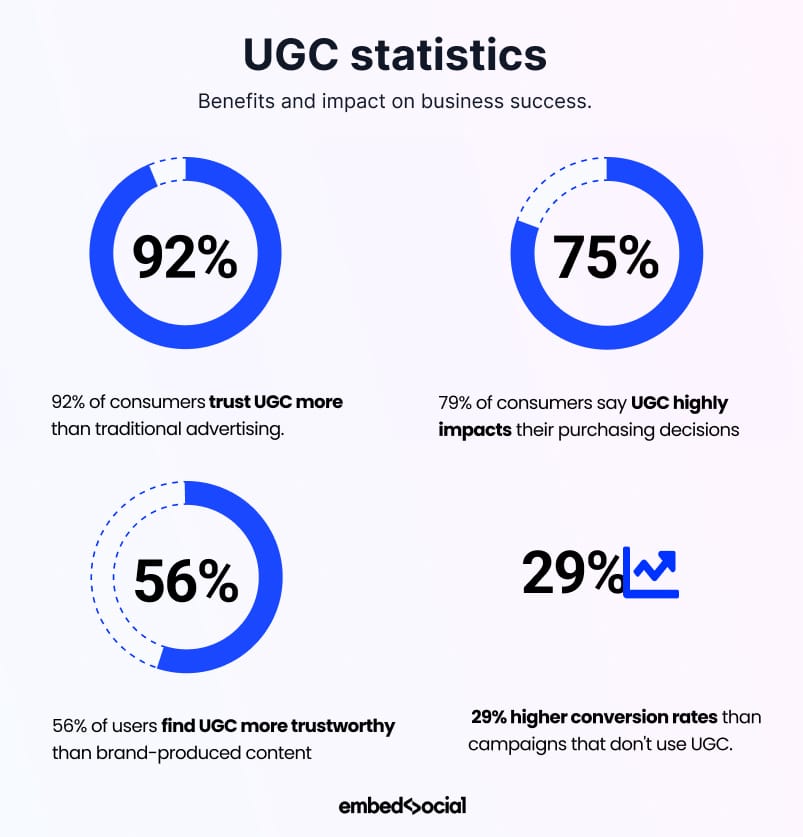
FYI: You can embed user-generated content on your website automatically. Sign up now.

Generate social proof & user-generated content automatically
#1 UGC platform to automatically generate, save, analyze, and display UGC on your website.
How user-generated content can boost marketing campaigns: 13 experiences from experts
We asked marketing experts: Can you share a use case where leveraging user-generated content improved your marketing efforts? What were the takeaways? Here is what they shared:
- Engage community with authentic content
- Humanize brand with chatbot-curated UGC
- Showcase client success stories
- Build trust with hashtagged customer photos
- Enhance local SEO with customer photos
- Humanize niche markets with client stories
- Transform clients into brand ambassadors
- Create authentic brand community
- Uncover new service applications via UGC
- Gain authority with blogger collaborations
- Balance competitions with judged and social votes
- Scale brand reach with organic UGC
- Amplify B2B appeal with workspace UGC
1. Engage community with authentic content
One vivid example from our work at Ever Wallpaper was our “Design Your Own Space” contest. We invited our customers to submit photos of their rooms decorated with our wallpapers. This initiative not only engaged our community but also showcased the versatility of our products in real-life settings.
The enthusiasm and creativity of the participants led to a significant increase in our social media engagement and website traffic. From this experience, the key takeaway was the power of authentic, customer-generated content in building trust and fostering a sense of community.
It reminded us that people value seeing how others use our products in their diverse, unique spaces, which inspires more customers to trust in our wallpapers’ quality and aesthetic appeal.
Rengie Wisper, Co-Founder, Ever Wallpaper
2. Humanize brand with chatbot-curated UGC
In my role at the helm of MBC Group, we’ve leaned heavily into leveraging user-generated content to transform our marketing endeavors, particularly through our AiDen chatbot technology. This move manifested powerfully in a campaign we orchestrated for a burgeoning e-commerce platform specializing in handmade goods. We implemented a feature where customers could share their purchase experiences and photos via the chatbot, which were then curated for showcasing on the platform’s social media. This approach not only bolstered our engagement rates but significantly humanized the brand, fostering a strong sense of community among buyers and sellers.
Notably, the campaign resulted in a 45% increase in user engagement on the platform’s social media and a 30% uptick in repeat purchases. The tangible success lay in the authenticity and relatability of the shared customer experiences. This strategy underscored the potent value inherent in real, relatable customer stories over traditional, polished marketing narratives. It reinforced the idea that consumers are looking for genuine connections with brands.
From this experience, a key insight emerged: facilitating and encouraging the sharing of user-generated content can serve as a powerful marketing catalyst. It’s not just about the content itself but about fostering an ecosystem where customers feel valued and seen. This approach can significantly amplify a brand’s reach and resonance, transforming passive viewers into active participants and brand advocates. The effectiveness of user-generated content lies in its authenticity, offering a compelling, trust-building tool that can outperform traditional advertising means.
Matthew Montez, Founder, The MBC Group
3. Showcase client success stories
In a creative twist, Digital Web Solutions launched a user-generated content campaign inviting clients to share their success stories using our digital marketing services. The initiative, dubbed ‘Your Success, Our Mission,’ highlighted the tangible benefits our clients achieved and humanized our brand. One particularly memorable submission was a video from a small business owner whose revenue skyrocketed thanks to our targeted advertising strategies. This video, shared across our digital platforms, not only garnered significant attention but also demonstrated the real-world impact of our services on businesses.
The campaign’s success taught us a valuable lesson: when clients share their stories, it carries authenticity and trust that no traditional marketing can match. This strategy allowed us to showcase our expertise in digital marketing and AI in an engaging and persuasive manner. It underscored that behind every service we offer, there’s a story of growth and success waiting to be told. Leveraging user-generated content didn’t just improve our marketing efforts; it transformed how we connect with our audience, proving that the most powerful endorsements come directly from those we serve.
Vaibhav Kakkar, CEO, Digital Web Solutions
4. Build trust with hashtagged customer photos
Incorporating user-generated content (UGC) into our marketing strategy proved immensely beneficial. In one campaign, we encouraged customers to share photos and testimonials of their experiences with our product on social media using a specific hashtag.
The response was overwhelmingly positive, with customers sharing authentic stories and images that resonated deeply with our target audience. By showcasing real-life examples of our product in action, we not only built trust and credibility but also fostered a sense of community among our customers.
The UGC served as powerful social proof, validating the value of our product in a way that traditional marketing messages couldn’t match. The key takeaway from this experience was the importance of authenticity and genuine connection in marketing efforts. By giving our customers a platform to share their experiences, we humanized our brand and created a more meaningful dialogue with our audience.
Moreover, the UGC provided valuable insights into how customers were using our product in their daily lives, helping us tailor future marketing initiatives to better meet their needs. Overall, leveraging user-generated content proved to be a cost-effective and impactful way to enhance our marketing efforts, driving engagement, and building brand loyalty in the process.
Anna Learie, Outreach Specialist, Freya
5. Enhance local SEO with customer photos
At That Local Pack, our deep dive into leveraging user-generated content (UGC) specifically focused on local businesses in the cleaning and auto service sectors. A standout case was with a local car wash company we partnered with. We implemented a strategy where customers were encouraged to share before-and-after photos of their cars on social media, tagging the company and using a campaign-specific hashtag. This initiative not only showcased the quality of the service but also organically amplified our client’s online presence.
The results were immediately noticeable. We saw a 40% increase in engagement on the car wash’s social media platforms and a 25% uptick in bookings directly attributed to the campaign. The success of this strategy taught us two important lessons. First, the genuine satisfaction of customers, captured through their own lens, provides an authenticity that can’t be matched by conventional marketing content. Second, making the process engaging and easy for the customers encourages participation, which fosters a community around your brand.
Ken Fortney, Founder, That Local Pack
This approach underpins my belief in the power of UGC and its critical role in local SEO strategies. It not only boosts your online visibility but also significantly enhances community trust and loyalty. The key takeaway is that authentic customer experiences, shared in their own voices, are invaluable assets. They not only act as testimonials but also serve as a catalyst for organic growth, making UGC a cornerstone of effective digital marketing strategies for local businesses.
6. Humanize niche markets with client stories
At Palmetto Surety Corporation, leveraging user-generated content played a crucial role in redefining our marketing strategies, especially with regard to surety bonds—a market segment traditionally seen as dull and highly technical. We initiated a campaign encouraging our clients to share their success stories and the ease of securing surety bonds with us, highlighting our efficient process and supportive customer service. This content was shared across various social platforms using a specific hashtag we created for the campaign.
The campaign resulted in a 35% increase in engagement on our digital platforms and a remarkable 20% growth in bond applications within a three-month period. The user-generated testimonials acted as authentic endorsements, significantly boosting trust among potential clients. This initiative made it clear that even in niche markets like ours, UGC can be a powerful tool to humanize the brand, simplify complex services, and create relatable narratives that entice prospective customers.
Haiko de Poel Jr, Marketing Specialist, Palmetto Surety Corporation
The lesson here is substantial: no matter the industry, there’s an opportunity to leverage the voices of your satisfied customers to bolster credibility and attract new business. The key is to encourage sharing in a way that feels natural and rewarding to customers, and to then amplify these genuine stories across your platforms. This not only enriches your content mix but also builds a community around your brand, driven by authentic, trust-building customer experiences.
7. Transform clients into brand ambassadors
At Raincross, leveraging user-generated content (UGC) has been pivotal in humanizing our brand and deepening connections with our diverse clientele. One impactful example of this was during a campaign where we spotlighted customer testimonials on social media, particularly focusing on how our digital marketing solutions propelled their businesses forward. By sharing these real, relatable success stories, we not only showcased our capabilities in a real-world context but also created a platform for our clients to celebrate their achievements.
This strategy saw an immediate increase in our engagement rates. Over the course of the campaign, social media engagement soared by approximately 50%, and inquiries into our services increased notably. We learned that UGC isn’t just about plastering customer reviews on a website; it’s about creating a narrative that intertwines the customer’s journey with our brand’s identity. This approach fostered a sense of community and trust that traditional marketing methods could not achieve.
The takeaway from our experience is clear: authenticity sells. In a digital age where consumers are bombarded with content, genuine stories stand out. Implementing UGC allowed us to transform our clients into brand ambassadors, whose endorsements were far more persuasive than any marketing copy we could craft. It underscored the importance of listening to and sharing the voices of those who interact with your brand. This not only enriches your marketing strategy but also builds a loyal, engaged community around your brand.
Kevin Watts, President and Founder, Raincross
8. Create authentic brand community
In my experience at Plumb Development, focusing on creative and personalized digital marketing strategies, we found remarkable success with our “Bragging Rights” campaign for the auto industry. This initiative was designed to leverage user-generated content in a way that not only celebrated the consumer’s purchase but also authentically showcased their experience with the brand. By developing an “Instagram-esque” platform for new car owners to share photos and experiences, we tapped into the genuine excitement and personal stories of our customers.
The direct outcome of this campaign was an increase in engagement and a noticeable uptick in referrals. It became evidently clear that when customers shared their joy and satisfaction online, it served as a potent form of social proof. The user-generated content created through this campaign led to a ripple effect, generating additional interest and confidence in the brand among prospective buyers. The success of the “Bragging Rights” campaign was quantifiable, with a significant lift in both online engagement and physical dealership visits, driven by the authentic testimonials and shared experiences of our customers.
The “Bragging Rights” initiative highlighted two key takeaways:
First, the power of user-generated content lies in its authenticity—it has the ability to build trust and foster a community around a brand in ways that traditional advertising cannot.
Second, incentives for sharing, while they can be minimal, amplify participation rates and engagement. This strategy not only benefits the brand through increased visibility and authenticity but also rewards customers, creating a mutually beneficial ecosystem that can be leveraged across industries.
Brian Kratt, Founder and CEO, Plumb Development, Inc
9. Uncover new service applications via UGC
Using user-generated content (UGC) has been a key component of WorkStaff360’s marketing strategy, especially with regard to our customer testimonial campaign. Encouraging satisfied clients to post about their interactions with our virtual assistants on our website and social media has produced invaluable findings and advantages.
The campaign yielded some interesting insights, one of which was the identification of unexpected benefits to our services that even we were unaware of. We discovered through UGC that a large number of our clients were testing out new company ideas and endeavors in addition to assigning tasks to our virtual assistants. We now have more opportunities to promote our services to business owners and startups looking for adaptable and affordable help as a result of this unanticipated use case.
The importance of storytelling in UGC was another significant finding. Customer reviews enabled us to present actual cases where our virtual assistants had a noticeable impact on our clients’ businesses, rather than merely listing features and benefits. Our marketing became more engaging by using a storytelling approach, which also assisted prospective clients in seeing how our services could enhance their own business processes.
Aqeel Abbas, CEO, WorkStaff360
10. Gain authority with blogger collaborations
Partnering with digital creators in the Flagstaff area has helped our client, Americana Motor Hotel, elevate its profile on social media platforms!
We recently partnered with an Arizona travel blogger with an audience of 293,000 on a giveaway, and the results for Americana’s page were mind-blowing. Over the five days the giveaway was live, Americana gained 865 followers and got onto the Reel feeds of 63,000 new audience members from the blogger’s following.
Chelsea Evans-Flower, Owner, Scott Social
If local experts love and recommend the hotel, their followers will likely book a stay or visit—because who doesn’t love a well-vetted recommendation? Their collaboration and endorsement help the brand establish itself as an authority in the hotel industry even more.
11. Balance competitions with judged and social votes
Years ago, I orchestrated a baking competition for a baking supply retailer in San Diego. Together, we announced a cupcake competition where customers could send in photos of their homemade cupcakes, and the retailer would post the cupcakes on their Facebook page. Facebook users could vote on their favorite ones.
We did multiple contests over the course of a few years, using holidays as themes, such as Halloween and Christmas. The contests were a huge hit, and the retailer’s social media interactions skyrocketed. They even became so proficient with their social media that they were able to take over and start generating their own ongoing content to keep people engaged, even when there were no contests going on.
The biggest takeaway from the experience for me was that if you are going to hold a competition where people send in their creations, it’s important to have both a judged portion of the competition and social media likes and votes. This will help you avoid the occurrence of deserving creations not getting their proper due because their creators are bad at social media and don’t know how to get likes from people, and undeserving creations getting more likes and votes than they deserve because their creators happen to be good at social media.
When it comes to things like baking, people love to show off, and a friendly competition can go a long way toward increasing social media engagement if done correctly.
Rob Swystun, Content Strategist, Rob Swystun Content Marketing & Ghostwriting Inc.
12. Scale brand reach with organic UGC
We have seen great success using user-generated content (UGC), which is incredibly scalable. It has helped to broaden the reach of our brand by utilizing it across various social media platforms and enhancing our message through user sharing, leading to higher engagement.
The outcomes we’ve achieved demonstrate that this approach boosts organic reach, a much more cost-efficient method of promoting content than paid advertising. Additionally, user-generated content allows us to repurpose it for use in newsletters, print materials, and on our website.
We believe that the strength of user-generated content lies in its ability to spread organically through social media since it’s created by fans who are eager to share their experiences and photos with others. This organic spread makes UGC a fundamental element of our social media marketing strategy, ensuring it reaches user feeds where it can be seen and interacted with by a broader audience.
Patrick Beltran, Marketing Director, Ardoz Digital
13. Amplify B2B appeal with workspace UGC
In my experience leading the team at Cleartail Marketing, we’ve seen how incorporating user-generated content (UGC) can dramatically enhance our marketing efforts and those of our clients. One memorable instance involved a B2B client specializing in office supplies.
We encouraged their customers to share their workspace transformations featuring our client’s products on LinkedIn and Twitter. Using a specific hashtag for this campaign, we managed to not only increase our client’s social media engagement by 35% but also improved their lead generation by 25% within just three months. This strategy proved that even in a B2B context, authentic customer stories and visuals could significantly amplify a brand’s appeal and reach.
Magee Clegg, CEO, Cleartail Marketing
One key insight from this experience is that UGC provides a level of credibility that traditional marketing can’t match. Seeing real people in real work environments using our client’s products created a compelling narrative that prospective customers could relate to and trust. Importantly, we learned the value of actively engaging with and rewarding users who contribute content. By recognizing and sharing user contributions, we fostered a stronger community around our client’s brand, driving further participation and content generation.
Another critical takeaway was the importance of platform-specific strategies for UGC. The professional nature of LinkedIn made it an ideal platform for showcasing workplace transformations, while Twitter’s broad reach helped generate buzz and encourage further shares. Tailoring our approach to each platform maximized the impact of the campaign. Embracing UGC taught us that authentic customer experiences are invaluable in building trust, enhancing brand loyalty, and driving meaningful engagement. It’s a strategy that I believe can transform marketing efforts across industries, offering a genuine connection between brands and their audiences.
Magee Clegg
7 tips to start with user-generated content
Once you embrace consumer-generated content as an asset in your social media marketing toolset, follow a few standard tips and tricks to maximize your returns:
- Make your brand shareable—consider what is unique about your products and what you can do to facilitate a great experience for your customers: packaging, great service, a delivery surprise, an unexpected birthday card, a community event, and so on;
- Choose the right social networks—think about where your audience interacts online and where your potential customers and advocates could have the most significant influence. For instance, an e-shopping brand should use a visual platform like Instagram;
- Request permission to share content—you must devise and implement a robust system to obtain permission to use someone’s UGC, express your appreciation for the content in question, and promise the creator greater exposure once you reshare it;
- Credit the content creator—always tag the original content creator directly in the post, which makes it easier for fans and followers to verify that the content is authentic and created by a customer outside your company;
- Offer something in return—social media contests and giveaways are a great way to generate a substantial amount of UGC quickly. So next time you want your followers to provide you with user-generated content, consider what you can offer them in return;
- Analyze and measure your content—UGC metrics are great for customer research. So, take a closer look at how buyers are using your brand and what language they use to describe it. You might discover new ways of using your products!
- Re-use content across marketing channels—Your customer-generated content is also very flexible, allowing you to use it anywhere you are present, including your website and all your social media platforms.
Follow future UGC trends
The future of user-generated content (UGC) marketing points toward more immersive and integrated experiences. For that reason, e-commerce will further embrace UGC, embedding customer reviews, photos, and videos directly on product pages.
Also, video and live-stream UGC, including potential VR/AR experiences, will become more prominent, driven by platforms like TikTok and Instagram Reels, and AI will tailor UGC to individual interests, enhancing personalization and engagement.
Finally, testimonials and case studies will become crucial for trust-building in B2B marketing, whereas smaller D2C brands are expected to pivot towards niche-focused influencer partnerships, valuing community engagement over greater reach.
Enhance your UGC via a robust UGC platform
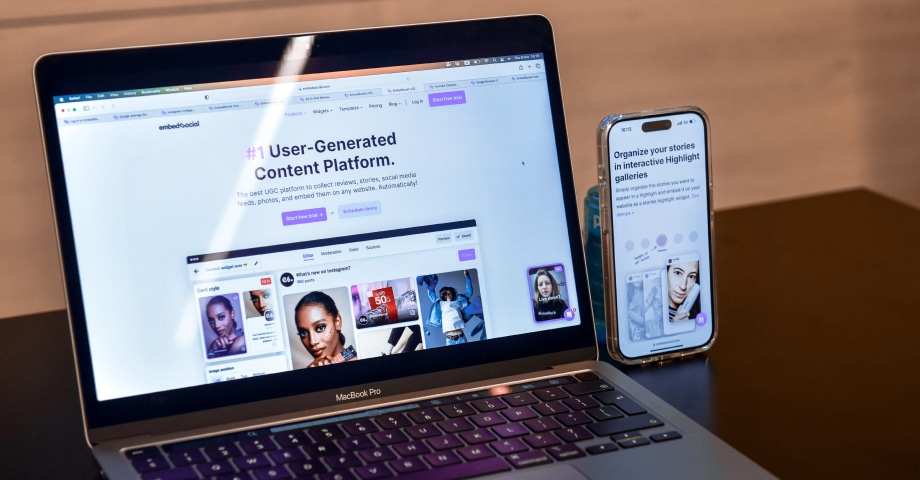
One of the biggest advantages of the best UGC platforms is that they allow you to create interactive UGC widgets from your best content and embed the UGC on a website.
For instance, a comprehensive user-generated content software like EmbedSocial will automatically collect all the customer-generated content mentioning your brand, display it into interactive website widgets, and provide you with insightful metrics about their impact on your conversion rates.
Also, consider your actual needs. For instance, if you are an e-commerce brand, you will want to create shoppable UGC feeds and automatically get UGC rights.
FYI: You can embed user-generated content on your website automatically. Sign up now.
Conclusion: Consumers trust content created by other users!
Instead of overselling your product with pricey social media marketing strategies, let others show the world just how good it is by repurposing their original content.
To get such content, encourage shoppers, professional content creators, micro-influencers, and industry experts to describe your brand in their own words and style.
However, as an online business, you should also be open to criticism by consumers and be willing to turn every piece of negative customer feedback into a lesson learned.
In any case, rely on UGC platforms as they can help you aggregate all the authentic user-generated content in one place and use it to enhance your marketing efforts.
FAQs about the UGC meaning
Why is UGC important for your social media channels?
UGC will help you connect with your target audiences. Also, it provides valuable insight into what consumers are interested in and how they perceive your brand.
Why is content moderation important for user-generated campaigns?
When launching a user-generated content campaign, such as hashtag contests or giveaways, it is important to state the rules and set up a monitoring process because you want to discover any content that might violate your brand. Sometimes, users can post a video that they might think is funny but can contain harmful language to certain people, that you, as a brand, want to disassociate. To do content moderation, you usually need a monitoring tool that will help you find the content on Instagram and report it.
What is user-generated content marketing?
User-generated content marketing involves leveraging content creation by existing customers or fans, instead of the brand, to promote products or services. It’s valued for its authenticity and ability to foster community engagement around a brand.
What is a user-generated content platform?
UGC platforms are SaaS software solutions that provide functionalities to easily aggregate, store, and reuse the customer content shared on social media or other channels and online profiles. For example, EmbedSocial is a complete UGC platform that enables brands to collect and embed social media posts or reviews published by other people on Facebook and Google.
How to get user-generated content?
The best way to get user-generated content is by incentivizing or encouraging your customers to share their experiences. For example, ask them to write testimonials in return for swag or create ‘deliberate’ experiences that people won’t hesitate to talk about and share, such as exciting packaging, social initiatives, exceptional customer support, etc.
How can I encourage UGC?
You can encourage more users to generate UGC content for your brand in a few different ways, including hosting competitions and giveaways, generating content, using hashtags to encourage social media engagement, and featuring UGC on your website or blog.
Are there any risks associated with using UGC?
There are a few risks associated with using user-generated content. This includes the potential for negative or fake reviews, copyright issues, and reliance on social media platforms. So make sure that you get full permission to reuse your customers’ content, especially if you display their images or other content in mass-marketing campaigns.

